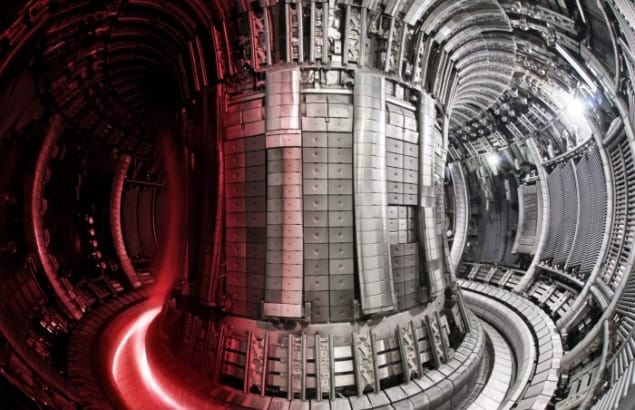
More than 750 people have signed a petition against the planned closure of the Joint European Torus (JET), a major fusion experiment that has been running in the UK for almost 40 years. The UK Atomic Energy Authority (UKAEA), which operates JET, plans to shut down the nuclear fusion reactor in early 2024. The petition says the closure of JET would be “a serious scientific blow” that will have a “negative impact” on the worldwide fusion community.
JET has been carrying out fusion experiments since it opened in 1984. Over the past decade or so it has been doing “ITER relevant” experiments, in anticipation of the opening of the ITER fusion reactor, which is currently being built in Cadarache, France. In 2011, for example, JET had a refit of its plasma wall to include a mixture of tungsten and beryllium tiles so that scientists can gain a better understanding for how ITER’s beryllium plasma wall will perform.
The decision to shut JET was originally made in 2016 by the UK and EUROfusion – an umbrella organisation for fusion labs around Europe. The plan had been to close it this year because it was thought that ITER would be running, or about to open, by now. But with ITER not scheduled to come online until late 2025 – a date that is likely to be hit by further delays – those behind the petition warn that JET will now be turned off years before ITER fires up.
This gap will be worse given that ITER will begin with a hydrogen-deuterium plasma and only start using deuterium and tritium (D-T) in 2035. Under current plans, therefore, no D-T experiments will be carried out for at least a decade, with the final D-T tests on JET ending in mid-October. “ITER has always been seen as the successor of JET,” says petition co-founder Emilia Solano, a fusion researcher at the Madrid-based National Fusion Laboratory of Spain. “But now we are facing a huge gap in time between the two fusion experiments. We need to bridge that gap.”
Record breaker
The picture is complicated by the UKAEA becoming the sole owner of JET in 2021 and by the UK’s recent decision not to associate with the European Union’s nuclear-energy initiative EURATOM (to which EUROfusion belongs) and instead fund its own domestic fusion programme. The petition now wants the UKAEA to work with the European fusion community to find a way of bridging this gap between JET closing down and ITER starting up.
“JET still has a lot to offer,” Solano claims. In February 2022, for example, JET produced 59 megajoules (MJ) of fusion energy from a single five-second shot, beating the previous record in 1997 of 22 MJ. The petition also states that if JET is kept open, it should be upgraded to include a full tungsten plasma wall. ITER will use beryllium, which is “plasma friendly” but toxic and tricky to handle. There are proposals for ITER to instead use a full tungsten plasma wall.

Fusion energy record smashed by Joint European Torus facility
“If we also equip JET with a full tungsten wall, we can study the effect of this modification on the plasma in advance, and reduce the risks in ITER,” says petition co-signatory Jef Ongena, a fusion researcher at the Laboratory for Plasma Physics of the Royal Military Academy in Belgium. That view is backed Richard Buttery, another signatory who leads the DIII-D National Fusion Facility in San Diego, the largest magnetic-fusion facility in the US. “JET would provide valuable work that could ease challenges for ITER, and so bring this high value project to fruition more quickly, and with less risk,” he says.
Keeping JET open would also maintain know-how and ensure that fusion researchers can continue to be trained, with Ongena claiming that JET’s international team is a blueprint for how a future ITER team should operate. But Buttery says there will be challenges for staff if JET does close, with jobs already having been lost and maintenance deferred. “It would require a considerable effort and redirect of resources to claw some of this back,” he warns.
